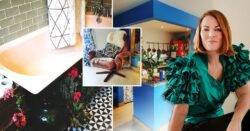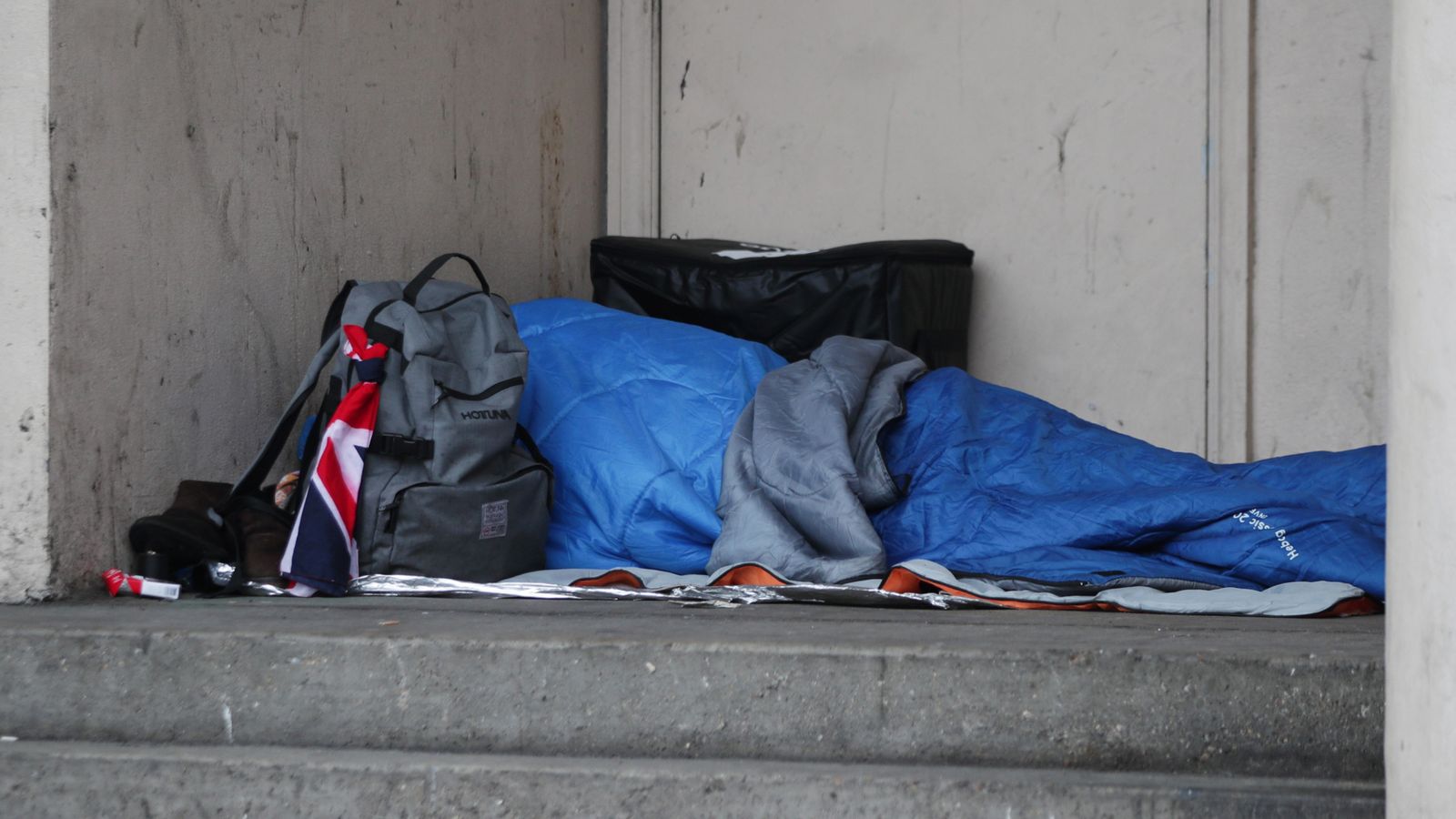Anna’s ‘luxury’ second hand home (Picture: @not.needing.new)
Anna Kilpatrick, 50, is giving me a Zoom tour of her stylish apartment. ‘Here are my beautiful copper pans! Look at my tiles! Do you like this bespoke OSB wood kitchen top?’
To be honest, I was more interested in the Isabel Marant top she was wearing. ‘Ah, this old thing,’ she laughs. ‘It cost me £2.50 from the charity shop.’
The copper pans, tiles and kitchen table legs are also all vintage finds, scavenged from the tip, a skip and charity shops.
Anna is part of a growing movement of second hand clothing and furniture influencers who are taking social media by storm. Keen to cut down their carbon footprint, TikTik is full of Gen Zers flaunting their bargain buys.
But Anna, who has 44,000 Instagram followers, says the movement isn’t just for teens and twentysomethings. For her, this way of life started as a necessity.
Who’d guess some of this came from the tip? (Picture: @not.needing.new)
After a divorce and losing her four-bedroomed family home, Anna had to start again at 40. With her two children 7 and 4, she moved into a tiny third floor flat, her ex-husband had survived a significant brain injury and Anna had the financial responsibility.
‘It was in a grim state, but it was the one place that I could afford. There was a broken cooker with a camping hob strapped to it, the white kitchen sink was yellow with stains, there was a green shag carpet like tattered moss and just one storage heater in the whole place,’ she says.
‘The flat only had two bedrooms, which I gave to the kids. I made myself a bed that went over the hot water cylinder in the airing cupboard space with a curtain. There was no window, just a little round air vent like a tumble dryer hole which I used to stuff a jumper into when it was really cold on winter’s night. (Although now I have a little wooden sliding door for it now!) It sounds awful but it is really cosy!
‘I have slept up there for six years now. I felt it was very important to give the children their own bedrooms. We’d lost the family home, we don’t have a garden of our own any more, so I wanted them to have some sort of a space that was theirs.’
Anna’s small but cosy bed above the hot water tank (Picture: Anna Kilpatrick)
Anna was working full time as Head of English in a local school but still found it difficult to survive financially and started to buy second hand clothes. She furnished the flat almost completely from preloved furniture found on local Facebook sales and at the tip.
‘People kept saying things looked good or cool or stylish and I heard myself saying over and over again that it was from the charity shop, from the tip, found in a freebie box. I thought it would be good to try and show that you don’t need money, or youth, to be sustainably stylish. You just need a bit of bravado,’ she says.
Anna started to post her outfits on Instagram to her account @not.needing.new, and as her following grew, a literary agent came calling. She’s currently working on a book all about the ‘The Joy of Enough.’
‘I’m proud that I’ve keep my household going on very limited means, with no other support. I don’t feel ashamed of my second hand style and I feel so excited to write a book about this,’ she says. ‘It’s really important for the times we are in. The Joy of Enough is about being creative, feeling content and having fun despite not having a fancy lifestyle.’
Anna is keen to spread the message that life can be happy with ‘enough’ (Picture: Davina Paterson)
Her boyfriend Gus is a builder. A single dad with three children, who she lived with briefly (‘five children and two adults in his 2 bedroom house was not sustainable’) Gus has helped Anna renovate the flat – transforming the open kitchen with creative use of stud walls as framing, and creating homemade cupboards.
‘We built the worktops from my old kitchen table sawn in two, the copper pans I found at the tip, a retro classic mid century leather chair cost me £20 for and those gorgeous porcelain tiles came from a skip,’ she explains.
‘My new neighbour came up the stairs to see my flat recently. I told her that while I used to feel incredibly sad and defeated about losing the 4 bedroom house with a cascading woodland garden and ending up in lesser housing than I had as a student in Brighton in the 90s, I have come to a new place of acceptance. Gratitude even.
‘We talked about the joy of enough. What if it were possible that everybody just stopped at enough? No bigger house, no better car, no further holiday, no 8th pair of shoes, no flatter television or more powerful shower – you just had what was enough and felt happy with each wonderful thing that you owned. A great cup, a perfect pan, a treasured towel, a pair of winter boots. You looked after each thing.’
The kitchen before the makeover (Picture: @not.needing.new)
The bathroom shortly after she moved in, and now (Picture: @not.needing.new)
Anna admits that she did look at buying a tiny terrace house last year.
‘I tried, and failed, to put in an offer big enough. I’m grateful I failed. I would now be unable to afford to be there at all with what’s happening to interest rates. We would be on very dangerous ground. Instead, we are here. I have happy, healthy teenagers.
‘We are warm enough, fed enough, safe enough; in a small community, within my means.’
How to feel happier with enough.
1) Try to notice at the point of buying, if you’re buying for your real life, or if you’re buying something for a fantasy, imaginary life you are creating. Will you actually use it, or are you just admiring it? Will it sit, gathering dust, while you carry on using your existing items that really fit into the real life you live?
2) Try to notice ’satiation’ – when you have enough of something. Just like with a huge meal, there is the perfect point, before discomfort, when you have had enough and it feels great! It’s the same with clothes and make up and shoes etc. The ‘enough’ point is the most comfortable and contented point of ownership and it’s really likely that you are already beyond it.
3) Think about an important person in your life, someone you really love. Try to visualise something they wear often. Can you ‘feel’ it? It could be grandma’s apron, or dad’s soft scarf. What item of clothing reminds you of them? What item of yours would do the same thing for them? To have fewer really meaningful signature items that hold memories and connections with people, will feel more rewarding than a wardrobe rammed full of barely touched clothes.
Anna’s interiors inspo? The local tip.





